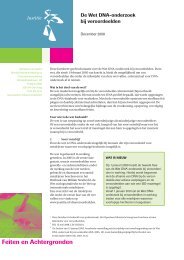INTERPOL HANDBOOK ON DNA DATA EXCHANGE AND PRACTICE
INTERPOL HANDBOOK ON DNA DATA EXCHANGE AND PRACTICE
INTERPOL HANDBOOK ON DNA DATA EXCHANGE AND PRACTICE
Create successful ePaper yourself
Turn your PDF publications into a flip-book with our unique Google optimized e-Paper software.
Summary• Training must be based on documented programmes with clearly identified learningoutcomes.• Training programmes should be written in accordance with international accreditationguideline formats.• Training programmes should be competency-based, with a formal assessmentresulting in a formal authorization, thus allowing the individual to perform the workof which he has successfully demonstrated a command.• These programmes should be delivered on a command basis allowing for differencesin learning rates, but with upper time limits to ensure efficient and cost-effectivetraining schedules.• Alongside all relevant technical aspects of the methods employed, the programmesshould also cover QA, proficiency testing and audits.• Training on statistical approaches to <strong>DNA</strong> evidence is essential.• Training must also include comprehensive understanding of the relevant legislation.• Training programmes must include expert evidence training, preferably utilizing localPublic Prosecutor/Defender office personnel, and subjects such as video techniques.• Training programmes should also contain awareness information regarding privacyand civil liberty issues.• These programmes are to be delivered within forensic laboratory training systems,via associated tertiary education institutes, and formalized programmes with legaloffices responsible for prosecution/defence and court services.•legal courts and the judiciaryPerhaps the greatest requirement under this heading is to ensure that all parties havea clear understanding of what are <strong>DNA</strong> and the forensic <strong>DNA</strong> profiling process weemploy to provide evidence to Courts. The fact that forensic <strong>DNA</strong> profiling currentlyutilizes non-coding areas of the <strong>DNA</strong> molecule is fundamental to understanding thesignificant variability that can be demonstrated between individuals. It is thereforeessential for any jurisdiction to dedicate significant effort to educating/training courtofficers in regard to the process, the capabilities and the limitations of forensic <strong>DNA</strong>analysis. There are many issues, situations and scenarios that must be appreciated bythese people in order to realize the full value of <strong>DNA</strong> evidence in the various tribunalsin which it is introduced. Trace <strong>DNA</strong>, degraded sample, mixtures of more than oneperson’s <strong>DNA</strong>, and contamination from the environment in which the sample is left orfrom interfering agents that may be present, all impinge on the <strong>DNA</strong> results obtainable.Awareness and understanding of these, perhaps as limitations to the process, areimportant training issues.PAGE 48TRAINING







